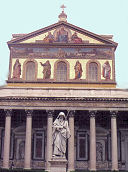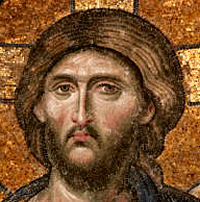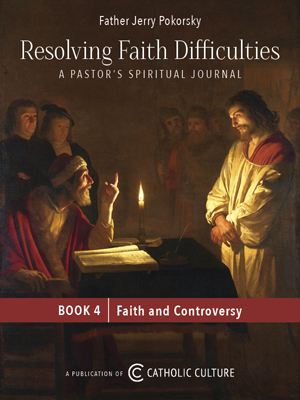» Enjoy our Liturgical Seasons series of e-books!
The first eight days of the Easter season form the Easter octave and are celebrated as solemnities of the Lord. Each day is another little Easter. The Alleluia verse is repeated throughout the octave: "This is the day the Lord has made; let us rejoice and be glad. Alleluia!"
The Risen Christ is the same Person as the Crucified Christ. The glorified body of the Risen Christ was so beautiful and resplendent that men might well say: The Risen Christ is not he, Christ of Gethsemane and Calvary. But Our Lord's five glorious wounds are the most certain link between Good Friday and Easter Sunday.
How beautiful are the lessons taught us by the five glorious wounds. They show us that the glory of Christ's body was the merit of His Passion and Death, and that I myself shall be glorified with Him only if I first suffer with Him. At the same time they continually remind the Blessed Trinity in heaven, as it were, of all that Christ suffered for us and are thus a prayer, an intercession, a source of forgiveness and graces for us.

At Rome, the Station for today is in the basilica of St. Paul Outside the Walls. The church is impatient to lead her white-robed newly baptized to the Apostle of the Gentiles. Though he is not the foundation of the Church, he is the companion of Peter's labors in Rome, his fellow-martyr, and the preacher of the Gospel to the Gentiles.
The Gospel continues to relate the story of Christ's resurrection—how Mary Magdalene and the other Mary meet Jesus. Jesus tells them "Do not be afraid. Go tell my brothers to go to Galilee, and there they will see me." We also read about the chief priests paying the Roman guards to spread the story that the disciples came while they were sleeping and stole the body of Christ.
During the Easter Season, the First Reading is taken from the Acts of the Apostles. Today is Acts 2:36-41. Peter is preaching on the day of Pentecost to the Jews: "The whole House of Israel can be certain that God has made this Jesus whom you crucified both Lord and Christ....You must repent and....be baptized in the name of Jesus Christ for the forgiveness of your sins, and you will receive the gift of the Holy Spirit." They repented, and 3000 were baptized that day.
Our Easter joy should be overflowing. A wonderful Ukrainian (and Polish and Slovakian) custom is the greeting of one another with the words: Khrystos Voskres (Christ is risen). The answer to this greeting is Voistynu Voskres (He is risen, indeed or He is truly risen). Let us adopt this custom to our English language and show our Easter joy to all.
See Catholic Culture's Easter Workshop for celebrating the Easter season.
Meditation: Mary Magdalen
At the tomb of the risen Savior, Mary was made an apostle: “Go to My brethren [the apostles] and say to them: I ascend to My Father and to your Father.” The liturgy lingers about the tomb today with the penitent Magdalen, to whom Christ first appeared after appearing to His mother. At Mass the Lord comes to us as He came to Mary at the tomb.
2. “Mary stood at the sepulchre without, weeping. Now as she was weeping, she stopped down and looked into the sepulchre; and she saw two angels in white…. They said to her: Woman, why weepest thou? She saith to them: Because they have taken away my Lord, and I know not where they have laid Him. When she had thus said, she turned herself back and saw Jesus standing; and she knew not that it was Jesus.” St. Gregory thus comments on this touching incident:
Mary Magdalen, who had been a sinner in the city, by loving the Truth washed away the stains of her crime with her tears….”Many sins are forgiven her, because she has loved much” (Luke 7:47). She who formerly had remained cold in her sin, afterwards became fervent with holy love….Of the disciples [who had come to the tomb] it is written: “The disciples therefore departed again to their home” (John 20:10). And then is added: “But Mary stood at the sepulchre without, weeping.” What a great love glows in the heart of this woman, who did not leave the tomb even though the disciples left!...She sought Him in tears, and inflamed with the fire of love, she burned with yearning for Him whom she thought had been taken away. Thus it happened that she alone then saw Him, she who alone had remained to seek Him.
The former sinner, the penitent, is the chosen one of the Lord. She is allowed to see Him because she had loved much and because she remained to seek Him. The sign of real virtue is perseverance. “He that shall persevere to the end, he shall be saved” (Matt 24:13). Would that we had such a longing for Christ as Magdalen had! Would that we could love as she loved! Our hearts are filled with worldly desires, and we have little room left for Christ. We are so attached to the foolishness and emptiness of the world that we have no love for Christ.
“Why weepest thou? Whom seekest thou?” Christ asks Magdalen. She thinks that it is the gardener addressing her, and she says to Him, “Sir, if thou hast taken Him hence, tell me where thou hast laid Him and I will take Him away. Jesus saith to her: Mary. She, turning, saith to Him: Rabboni (which is to say, Master).” She then casts herself at His feet, seeking to kiss and embrace them. Now she thinks she will never lose Him whom she has found. Christ does not permit this expression of her love. She has more important duties now. “Go to My brethren and say to them: I ascend to My Father” (Gospel). Mary obeys at once. She tears herself away from Him who she loves and brings the glad news to the apostles.
3. Today the Lord appears to us in the Mass and calls us by name as He once called Magdalen. He called us by this name first when we were baptized. Today we should come to Communion with a longing similar to Mary’s.
When we have recognized Him and received Him in Holy Communion, we also become apostles. Our mission is to love our neighbor. By our zeal in the practice of fraternal charity we give testimony to the world that Christ is risen and that He continues to live and work in us, the members of His mystical body. Having done penance, Magdalen now knows only the joy of possessing Jesus. We must share her joy.
—Benedict Baur, OSB, The Light of the World
Meditation—Christ Jesus, Our Elder Brother
What does Jesus Himself say to Magdalen when already in the glory of His Resurrection? “Go to My brethren”: Vades ad fratres meos. And how great is His “fraternity”! God as He is, this Only-begotten Son takes upon Himself our infirmities, He makes Himself responsible for our sins, in order to be like unto us; and restore to us the possession of the eternal Kingdom of Life with the Father.
For it is to the Father that Jesus leads us. Listen to what He says on leaving His disciples: “I ascend to My Father and to your Father, to my God and to your God”; the Word has come down from Heaven to take upon Himself our flesh and to redeem us; His work accomplished, He ascends to Heaven, but He does not ascend alone; He virtually takes with Him all who believe in Him.
And why?
In order that—in Him again—the union of all with the Father should be accomplished: Ego in eis et tu in Me. Is not this Jesus’ supreme prayer to the Father? “That I may be in them, O Father—by My grace—as Thou in Me, that they may contemplate, in the Divinity, the glory which Thou has given Me.”
—Dom Columba Marmion, Christ, the Ideal of the Monk

Tuesday in the Octave of Easter
Station with San Paolo fuori le mura (St. Paul Outside the Walls):
At Rome, the Station for today is in the basilica of St. Paul Outside the Walls. The church is impatient to lead her white-robed newly baptized to the Apostle of the Gentiles. Though he is not the foundation of the Church, he is the companion of Peter's labors in Rome, his fellow-martyr, and the preacher of the Gospel to the Gentiles.
For more on San Paolo fuori le mura, see:
For further information on the Station Churches, see The Stational Church.








